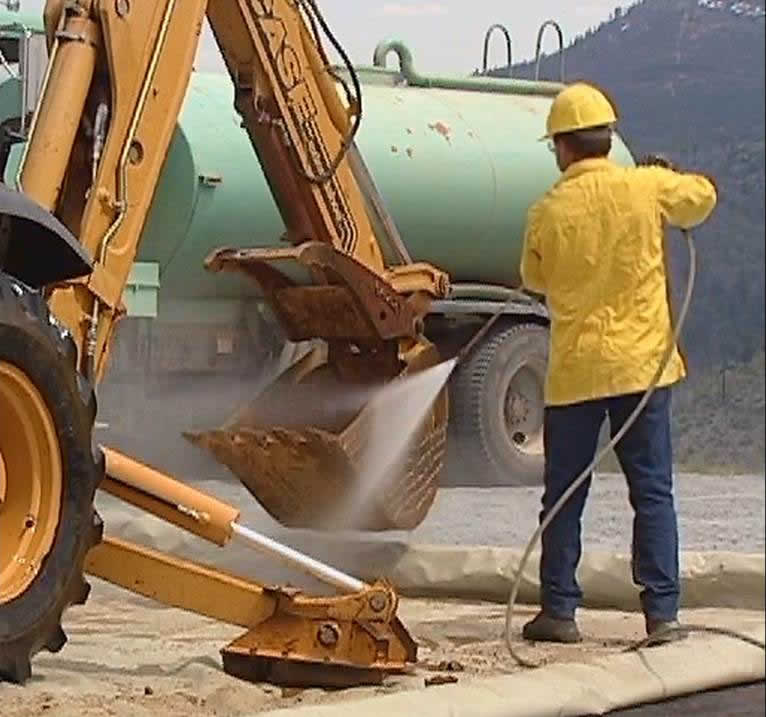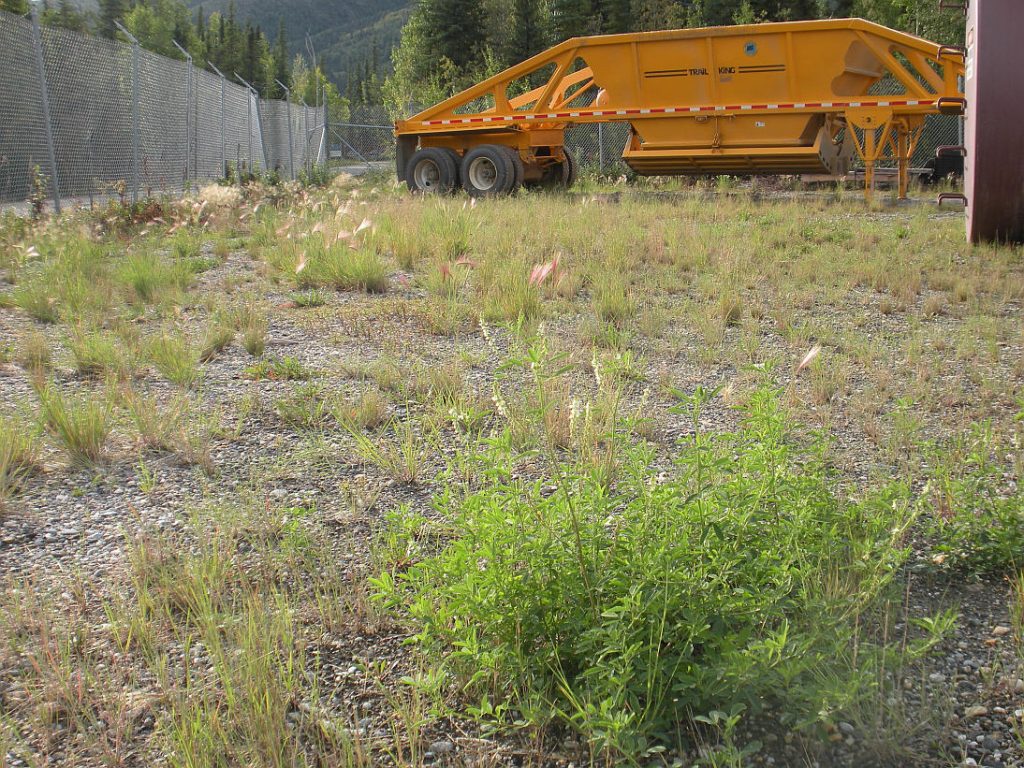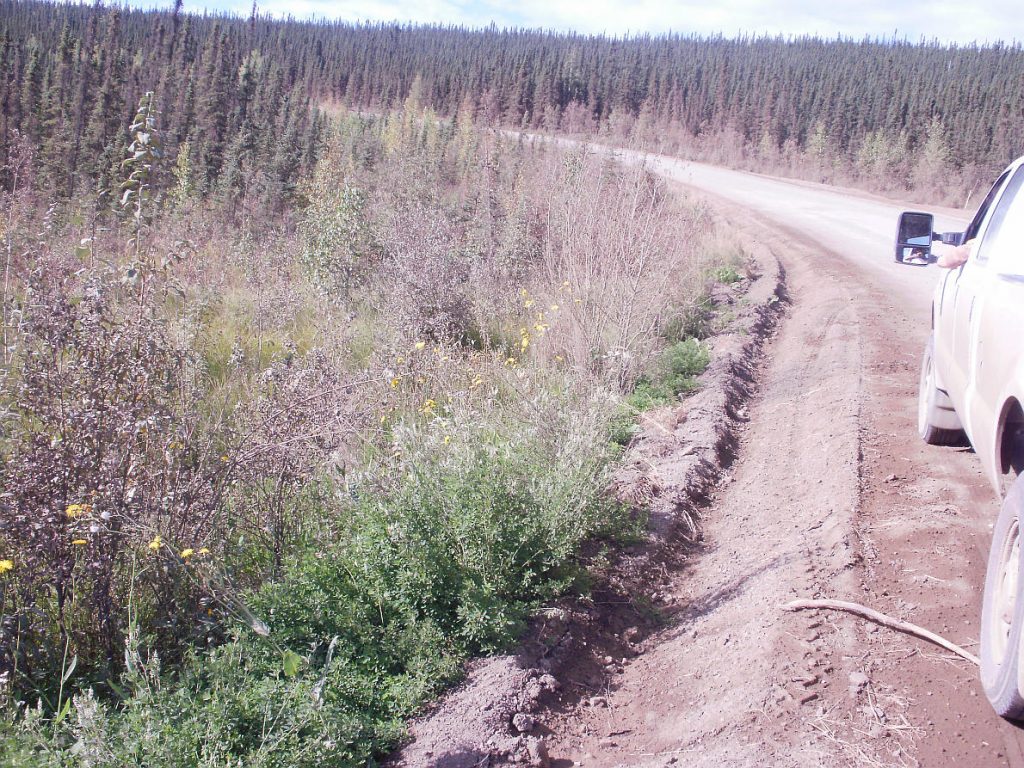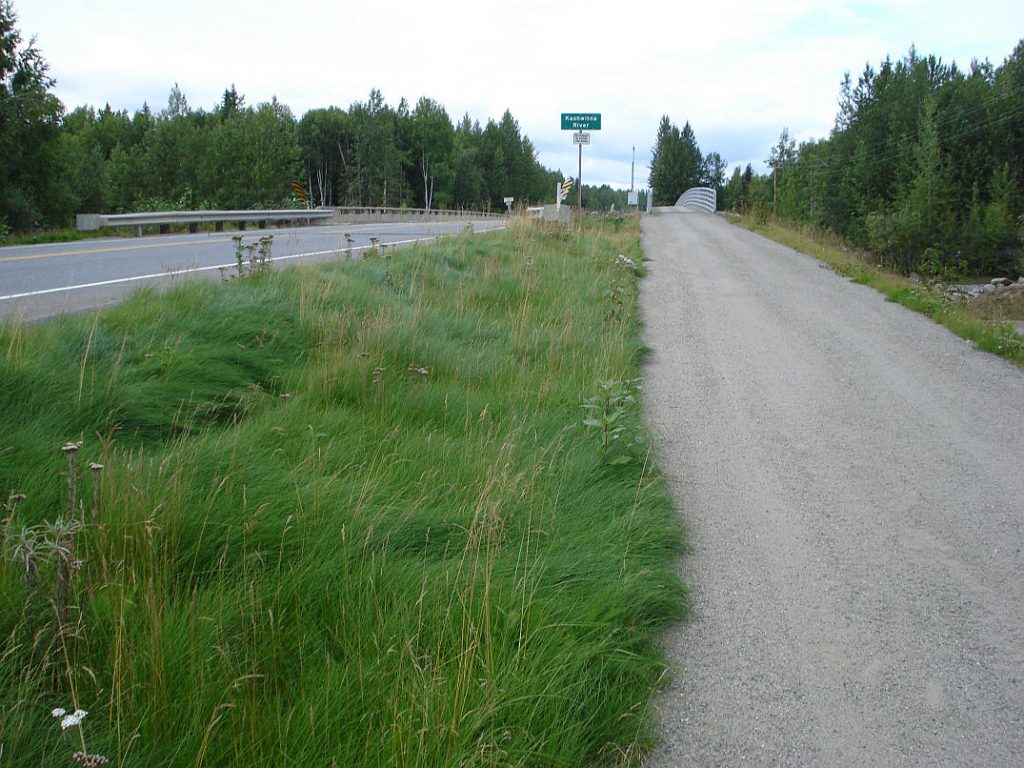Integrated Vegetation Management
This section will discuss concepts of integrated vegetation management, and then discuss control options for some high priority invasive plants.
Integrated vegetation management (IVM) is a common sense approach to managing vegetation that achieves the desired outcome using the plant’s biology to identify effective, safe, and efficient methods of control. IVM uses five general methods of control: prevention, physical, biological, cultural, and chemical. Below is a description of each of these methods.
Prevention: Includes approaches such as using certified weed free materials, and cleaning equipment to prevent movement of seeds of weeds. Prevention measures should always be part of an IVM plan.
Physical: Includes mowing, and hand pulling.
Biological: Using biological organisms such as insects, grazers, and pathogens to control a weed population. Grazers may be appropriate on some utility rights-of-way, but may be problematic in areas where vehicular traffic is present. Insects and pathogens can be effective, however they require large populations of the weed and extensive preparation that can take many years to be approved. In Alaska, there are no weeds with both a high enough population, and an approved insect or disease biocontrol agent. Biological control is not discussed with the weed species highlighted in this section.
Cultural: Actions that promote desirable vegetation are considered cultural methods for controlling weeds. Examples of cultural methods includes revegetation of bare ground with plants that will outcompete weeds, and activities such as mowing that promote the growth of desirable grasses while eliminating the weeds. Revegetation is key to effective cultural control. For strategies to revegetate refer to the Alaska Division of Agriculture, Plant Materials Center publication “A Revegetation Manual for Alaska” (http://dnr.alaska.gov/ag/RevegManual.pdf).
Chemical: Herbicides are used to control a variety of weeds, and is sometimes the most efficient method of control when eliminating a weed infestation is desired. In Alaska, all applications to land you do not own or manage must be made by a certified pesticide applicator. Become familiar with additional times one needs to be certified to use pesticides by reading the Department of Environmental Conservation Fact Sheet. In some cases a pesticide use permit may be necessary, and in others an integrated pest management plan is needed without a permit. Read the information on when you need a permit or IPM plan at the DEC website, and contact the Alaska Department of Environmental Conservation for information on when a permit is necessary if you are still unsure. The University of Alaska Fairbanks, Cooperative Extension Service provides courses and proctors tests for certified pesticide applicators in Alaska. This course identifies herbicides that will work with bird vetch, though we do not present an exhaustive list of chemicals or products. Many products may work just as well, particularly different brand names with the same active ingredient.
Timing chemical and non chemical control is critical because the chemical used may only be effective at certain life stages of the plant. Life stages of bird vetch that are pertinent to control include:

Product labels provide detailed instructions on how to apply the chemical, and what is the maximum amount you can apply per year. You can also find application rates on product labels. Generally speaking, if you and others in the area do not have experience controlling the plant we recommend using the higher rate, and if you desire to use a lower rate do so on a small portion of the infestation so that you can monitor the effectiveness. Treatment methods covered include broadcast and spot treatments. After treatment with a chemical the plants absorb the toxin which is distributed throughout the plant. The distribution of these chemicals throughout the plant is critical to success of the control effort. Treated plants must remain undisturbed for up to two weeks following treatment to be successful.
When weed seed is suspected to contaminate soil in the surrounding area of the targeted infestation it may be prudent to treat the soil with an herbicide that has residual soil activity. The residual soil activity of the chemical will kill seedlings that sprout later in the season, and in some cases in future years. Active ingredients aminopyralid and clopyralid are examples of herbicides that have residual soil activity. Care should be taken though with the use of persistent chemicals with residual activity. Plans for future revegetation should be considered to avoid the effects of soil persistent chemicals on sensitive species. If fill material is moved from the site it may contain the herbicide, and disrupt revegetation efforts in the area it is moved to.
After treatment of weeds with herbicides it is imperative to monitor for effective control, and to avoid developing herbicide resistance in a species. If some of the plants are not affected by an herbicide they may be resistant to the chemical mode of action chosen. If those resistant plants produce seed their offspring may also be resistant. Control those unaffected plants with another method or choose a new herbicide with a different mode of action. Planning ahead for resistance management by mixing two chemicals with different modes of action, or budgeting the time to implement mechanical or other control measures, will help with overall control effectiveness.
All herbicides have detailed instructions on how to apply the chemical to various sites, and species of plants. Labels are considered legal documents for the use of these chemicals. Always refer to the label for the appropriate way to apply that product.
a. Prevention – address pathways, what commodities need to be certified, inspected, etc.
Preventing the spread of bird vetch to new areas during construction, landscaping, regular maintenance, and recreational activities is the most effective method of control. Common ways invasive species biologists believe that bird vetch is spread include when it contaminates equipment, topsoil, fill and gravel. Following are some general tips and guidelines for practices that will help avoid spreading bird vetch.
Clean vehicles and equipment regularly
Vehicles and equipment collect dirt and debris when in use. With the dirt and debris comes seeds and other parts of plants (roots and stem fragments) that are capable of spreading to a new area. Scientists have sampled dirt stuck to vehicles and found seeds in areas such as wheel wells, behind license plates, tire treads, and other areas that collect dirt and debris. One Alaska community on Annette Island uses a vehicle wash station at the ferry terminal. They sent the dirt and debris to the Alaska Plant Materials Center for analysis, which showed they captured viable seed from washed vehicles. Weed species such as spotted knapweed (Centaurea stoebe) have been found primarily in places that serve as vehicle pullouts or potential staging areas for equipment or recreational vehicles and serve as an example of weeds that may contaminate vehicles and equipment. Regular cleaning of vehicles will help prevent the spread of weeds.
Below are the ideal steps you may take to wash vehicles and equipment:
- Clean vehicles and equipment using a pressure washer or compressed air. Focus on wheel wells, tire treads, bumpers, and other areas that can collect dirt or debris.
- Ideally clean vehicles prior to leaving a weedy location. Doing this ensures that the weeds are left at the site instead of dislodging from the vehicle en route to where the equipment is staged until further use. Limited access to water or compressed air may leave you unable to clean vehicles or equipment before leaving a weedy area. When it is not possible to clean the vehicles and equipment before leaving a weedy area clean vehicles and equipment in a designated area such as the maintenance yard.
- When returning to the maintenance station or equipment staging area clean vehicles.These are good areas to clean vehicles because cleaning equipment is regularly accessible, and monitoring for and management of weeds that start to grow because they were washed from vehicles or equipment is easier in areas that are regularly occupied by employees.

Avoid infested areas
Weeds established in a particular area are easily spread if vehicles and equipment park in or travel through infested areas. If work is scheduled to be done in weedy areas then other best management practices will be used. Avoiding infestations is about choosing equipment staging areas and travel routes that are free of weeds.
The ideal steps to avoid infestations:
- Do not travel through infested areas
- Do not park or stage equipment in infested areas.
- If an infested area is used control weeds to prevent additional seed development.
- If an infested area is used wash vehicles and equipment when leaving the area.

Work from uninfested to infested areas
Ripe seed or seed and other propagative parts of plants (root and stem fragments for example) are spread from one area to another when mowers, graders, and other work is completed in infested areas. If work in infested areas is unavoidable, and cleaning equipment during the field day is not possible, then one strategy is to work in those areas last to prevent moving those weeds to new areas. For example if you are mowing brush in a utility corridor, and the north end has no weeds while the south end has an abundance of bird vetch then starting work at the north end of the utility corridor will help prevent spreading the bird vetch from south to north. In many cases areas furthest from towns are the least infested areas.

Use certified weed free materials
Materials such as gravel, and straw used to make erosion control materials can be available as certified weed free products under a program managed by the Alaska Division of Agriculture. National standards are set by the North American Invasive Species Management Association, and individual states are allowed to add to the lists of weeds not allowed in such a product. Originally this started as a weed free forage program, that later was adapted to straw, and gravel. Information about the Alaska programs are found at http://plants.alaska.gov/invasives/weed-free.htm. A field or pit is inspected during the growing season. Gravel pits are inspected twice, and hay or straw are inspected within 7-10 days of harvest. A field or gravel pit cannot have listed weeds present to pass inspection, however, inspectors may flag off part of a field that a can be harvested. If certain listed weeds are present but not in seed, a management plan can be implemented to allow for the commodity to pass certification. Storage areas for the products must also be inspected. Take some time to view the inspection standards and list of weeds for weed free forage/straw, and gravel.

Seed should also be weed free. By regulation (11 AAC 34.010 – 34.070) in order for seed to be sold in Alaska it must be inspected, although with a different list of weeds than weed free forage and gravel. Seed is required to abide by the State of Alaska Noxious Weed list (11 AAC 34.020) which includes prohibited weeds which cannot be present in the seed, and restricted weeds which have allowable tolerances for contamination of seed. The weed free forage/straw, and gravel certification programs uses a more stringent list that includes additional species of concern. When purchasing seed, gravel, topsoil, and erosion control materials made from straw it is generally preferable to buy locally produced materials. Many weeds that are abundant in other parts of North America are not present in Alaska, or are presently in very low numbers. Purchasing locally produced materials lessens the risk that those weeds are repeatedly introduced to Alaska.
b. Mechanical/manual
Mechanical and manual control options for bird vetch include mowing or pulling. If done frequently either mowing or pulling bird vetch can significantly reduce the vigor of bird vetch, but will not likely eradicate it. Regular mowing and pulling also serves to reduce or eliminate seed production.
c. Weed barriers
In some instances weed barrier fabrics can be appropriate for use in bird vetch control. One such example is in ornamental landscape plantings around trees or shrubs. However, eventually the weed barrier will need to be cut back from the base of a tree or shrub to avoid choking out the trunk. Weed barriers are often not able to eradicate plants because the creeping roots of plants like bird vetch will spread to the edges of the weed barrier and send up new sprouts. Sometimes the edge is right at the tree or shrub trunk.
d. Herbicide
Herbicides can be highly effective at managing bird vetch. Herbicides are sometimes the most effective at certain growth stages of a plant, and for bird vetch that is the early growth phase, when the plants are short and have some leaves. As bird vetch grows plants become less susceptible. Bird vetch can be forced back into the early growth phase by mowing.

Different herbicides have legal restrictions on where they can be used, and pros and cons in different situations. Here we will discuss some herbicides that control bird vetch, some of their label restrictions, and maximizing benefit while minimizing impact of each herbicide. Note that we discuss the active ingredient, and there are many brand name herbicides associated with each active ingredient. Brand name herbicides, not the active ingredient, are registered for use on specific sites. It may be legal to use one brand name in a residential setting, while another with the same active ingredient cannot be used in that setting. Always read the label to appropriately use the product. The label is the law.
Triclopyr
Triclopyr works very well on bird vetch. Triclopyr is an active ingredient often found in tree and brush killers, is also effective on a variety of broadleaf plants, and does not affect established grasses. Triclopyr works through absorption through leaves, stems, and roots. Some products containing triclopyr are registered for use in residential and other landscapes in addition to a variety of other sites. Triclopyr is not a good herbicide choice for work around trees and shrubs in a landscape setting. Even if you only spray the bird vetch absorption of triclopyr by woody vegetation through the roots is likely. Triclopyr also persists for a short time in the soil where it is available for root uptake so replanting an area where bird vetch was removed using triclopyr may require waiting until herbicides are no longer present. This active ingredient is an excellent choice for use in areas where woody vegetation management is desired in addition to the removal of bird vetch.
2,4-D
2,4-D works moderately well on bird vetch with some having experienced a resurgence of the plant after management. 2,4-D is an active ingredient often found in products used on lawns, and is incorporated in many products that are available for use on almost any site. The herbicide works through absorption through leaves, stems, and roots. 2,4-D may be a good choice for managing bird vetch around desired trees and shrubs, however, care must be taken to not contact those trees and shrubs. Over-application can also lead to root uptake. If applied only to the bird vetch plants when small, with little overspray onto the root zone, significant damage to desirable trees and shrubs should be avoidable. While 2,4-D is not the best herbicide for eradicating bird vetch it is one of the only herbicides that may be a good choice in residential landscapes where desirable woody vegetation could be impacted.
Clopyralid and Aminopyralid
Clopyralid and aminopyralid both work very well on bird vetch, and they have similar physical properties and restrictions so will be discussed together here. Clopyralid is an active ingredient found in many products that are used to control a variety of broadleaf weeds in many settings, but does not damage established grasses. Aminopyralid differs from clopyralid because it is still on patent and only found in formulations of a few name brand products such as Milestone. These herbicides are active on plants through the leaves and stems, as well as uptake from the roots. These herbicides can damage trees and shrubs from root uptake after control of adjacent bird vetch, but damage does not appear on all species of trees and shrubs. Both of these herbicides persist in soil for some time after application, and remain available for plant root uptake. Persistence is desirable when you need to control a seedbank, but can be undesirable if quick transition to susceptible species is desired. For example, if these products are used to clear a field of bird vetch with the goal to establish potato, peony, peas, or another susceptible broadleaf plant you will have to wait an unknown time for the herbicides to degrade. Aminopyralid appears to persist longer than clopyralid, but in either case if transition to a susceptible species is desired a bioassay may be necessary to ensure herbicide is no longer bioavailable for plant uptake. These herbicides are an excellent choice when lasting control of bird vetch is desired on roadsides, forested areas, pastures and hay fields. Note however that restrictions on movement of hay and manure from livestock that have grazed fields treated with these herbicides exist because both herbicides will accumulate in grasses and manure.

For more information on bird vetch in residential landscapes see this video.
e. After control revegetate
Establishing vegetation after disturbance helps to control what plants will grow there. If left fallow, native vegetation may move in, but weeds or generally undesirable vegetation may move in. Vigorous non-invasive perennial grasses can prevent the establishment of weeds, and in many cases native species are commercially available. Information on revegetation in Alaska is found through the Alaska Plant Materials Center (www.plants.alaska.gov). The Plant Materials Center has manuals on revegetation and erosion control that detail species that will work, and their general availability in the state. Specialists on staff at the Plant Materials Center are able to help navigate their manual and provide assistance for specific revegetation issues.

Below are the ideal steps for revegetation:
- Revegetate after any disturbance
- Use native or non-invasive seed
- Use species that grow quickly and are adapted to the amount of disturbance in the right-of-way.
- Aggressive, but native or non-invasive species can prevent establishment of invasive species.
- Contact the Alaska Plant Materials Center (www.plants.alaska.gov) or an environmental analyst with the Department of Environmental Transportation for recommendations on seed mix.
